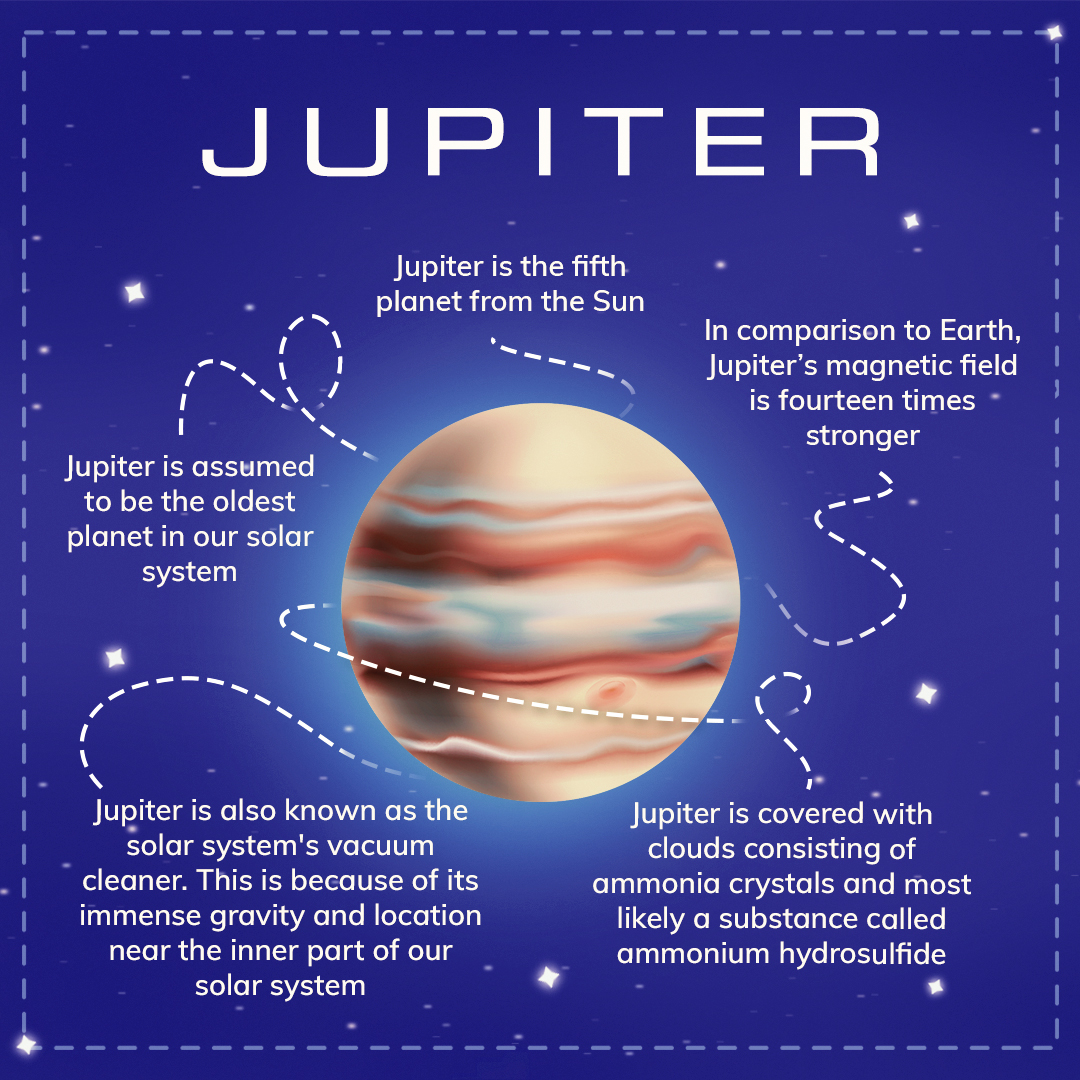Our planets: facts about planet Jupiter

Always wanted to know more about the planet Jupiter? Search no further! In this blog we’ll tell you everything about Jupiter. Read about what Jupiter looks like, where the planet is located in our galaxy and when you can view the planet from Earth!
Planet Jupiter is the fifth planet from the Sun and the largest planet in our solar system. The planet is named after the Roman god Jupiter, king of the gods. The planet is named after this god because of its massive size. Extraordinarily, Jupiter’s mass is 2.5 times that of all the other planets in the solar system combined!
What does the planet Jupiter look like?
Jupiter is a gas giant with a mass more than 2.5 times that of all the other planets in the solar system. Its mass is a little less than that of our Sun. Like other giant planets, Jupiter does not have a well-defined solid surface.
Jupiter is covered with clouds consisting of ammonia crystals and most likely a substance called ammonium hydrosulfide. This cloud layer of Jupiter is about 50 kilometers deep and consists of at least two decks of clouds: a thick lower deck and a thin deck. The clouds that surround Jupiter are orange and brown in color.
Flashes of lightning on Jupiter suggest that there is an extra layer of water clouds on the planet. In comparison to the Earth, the electrical discharges on Jupiter can be up to a thousand times more powerful than lightning on Earth.
The best known circumstance on Jupiter is called the Great Red Spot which is a storm located near the South Equator. This storm was most likely first discovered in 1665. Mathematical models suggest that the storm is a permanent feature of Jupiter and will therefore always be present on the planet. The Great Red Spot is a bigger storm than our Earth is big in size. The storm is visible through telescopes on Earth.

Jupiter and our galaxy
Jupiter is assumed to be the oldest planet in our solar system. Models of solar system formation suggest that Jupiter formed beyond the so-called ‘snow line’ which is a distance away from the Sun where temperatures are very cold. With such temperatures, it is not possible for water to condense.
In comparison to Earth, Jupiter’s magnetic field is fourteen times stronger. This causes Jupiter to have the strongest magnetic field of all astronomical objects within our solar system.
The location of the planet Jupiter in comparison to other astronomical objects
Jupiter is surrounded by a planetary ring in which almost a hundred known moons and possibly many more are located. Four moons that were discovered by Galileo Galilei in 1610 are called the Galilean moons. Ganymede, the largest of these, has a diameter greater than that of the planet Mercury.
Jupiter is also known as the solar system’s vacuum cleaner. This is because of its immense gravity and location near the inner part of our solar system. This causes more impacts on Jupiter, such as comets, in comparison to other planets.
Life on planet Jupiter?
Jupiter’s environment is most likely not suitable for life as we know it. The temperatures, pressures and materials that characterize this planet are too extreme and volatile for organisms to adapt to.
The temperature in the clouds of Jupiter is about minus 145 degrees Celsius. The temperature near the planet’s center is much, much hotter. The core temperature may be about 24,000 degrees Celsius. That’s hotter than the surface of the Sun!
While planet Jupiter is an unlikely place for living things, the same is not true for some of its many Moons. Europa is one of the likeliest places to contain life elsewhere in our solar system. There is evidence of a vast ocean just beneath this Moon’s icy crust, where life could possibly be sustained.
View the planet Jupiter
Want to view the planet Jupiter? You’re in luck! Jupiter is the fourth brightest natural object in the Earth’s night sky after the Moon and Venus. It has been observed since prehistoric times. Depending on Jupiter’s position with respect to the Earth, it can vary in brightness.
The four largest moons are Io, Europa, Ganymede, and Callisto, collectively known as the “Galilean moons”, and are visible from Earth with binoculars on a clear night.
Additionally, a small telescope will usually show Jupiter’s four Galilean moons and the prominent cloud belts across Jupiter’s atmosphere. A large telescope will show Jupiter’s Great Red Spot when it faces Earth.
In addition to viewing Jupiter from the Earth, there are also several space explorations that visit the planet. The latest probe to visit the planet, Juno, entered orbit around Jupiter in July 2016.
The planet Jupiter is full of surprises!
In this blog, we introduced you to our planet Jupiter, the fifth planet of our solar system measured from the Sun. Jupiter is a giant gas planet and the fourth brightest natural object in our night sky. Are you ready to test your knowledge of Jupiter? Travel through our galaxy and view our stars and planets with the OSR Star Finder App!
